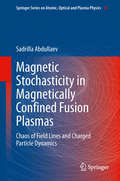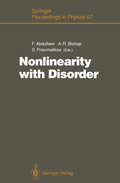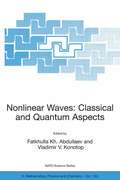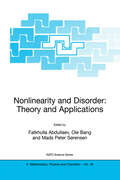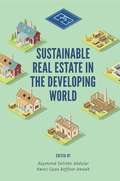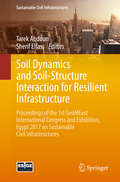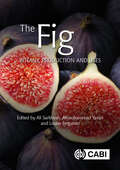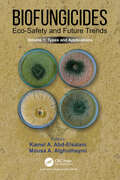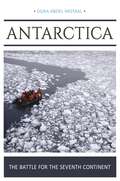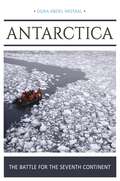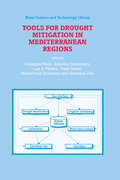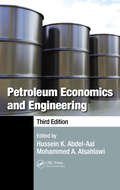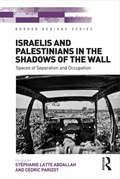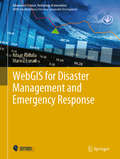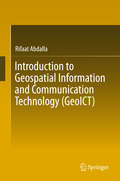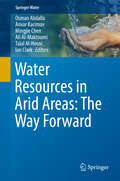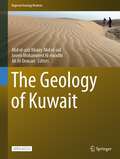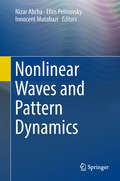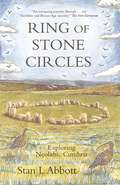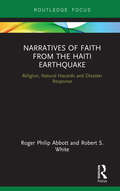- Table View
- List View
Construction of Mappings for Hamiltonian Systems and Their Applications (Lecture Notes in Physics #691)
by Sadrilla S. AbdullaevBased on the method of canonical transformation of variables and the classical perturbation theory, this innovative book treats the systematic theory of symplectic mappings for Hamiltonian systems and its application to the study of the dynamics and chaos of various physical problems described by Hamiltonian systems. It develops a new, mathematically-rigorous method to construct symplectic mappings which replaces the dynamics of continuous Hamiltonian systems by the discrete ones. Applications of the mapping methods encompass the chaos theory in non-twist and non-smooth dynamical systems, the structure and chaotic transport in the stochastic layer, the magnetic field lines in magnetically confinement devices of plasmas, ray dynamics in waveguides, etc. The book is intended for postgraduate students and researches, physicists and astronomers working in the areas of plasma physics, hydrodynamics, celestial mechanics, dynamical astronomy, and accelerator physics. It should also be useful for applied mathematicians involved in analytical and numerical studies of dynamical systems.
Magnetic Stochasticity in Magnetically Confined Fusion Plasmas: Chaos of Field Lines and Charged Particle Dynamics (Springer Series on Atomic, Optical, and Plasma Physics #78)
by Sadrilla AbdullaevThis is the first book to systematically consider the modern aspects of chaotic dynamics of magnetic field lines and charged particles in magnetically confined fusion plasmas. The analytical models describing the generic features of equilibrium magnetic fields and magnetic perturbations in modern fusion devices are presented. It describes mathematical and physical aspects of onset of chaos, generic properties of the structure of stochastic magnetic fields, transport of charged particles in tokamaks induced by magnetic perturbations, new aspects of particle turbulent transport, etc. The presentation is based on the classical and new unique mathematical tools of Hamiltonian dynamics, like the action--angle formalism, classical perturbation theory, canonical transformations of variables, symplectic mappings, the Poincaré-Melnikov integrals. They are extensively used for analytical studies as well as for numerical simulations of magnetic field lines, particle dynamics, their spatial structures and statistical properties. The numerous references to articles on the latest development in the area are provided. The book is intended for graduate students and researchers who interested in the modern problems of magnetic stochasticity in magnetically confined fusion plasmas. It is also useful for physicists and mathematicians interested in new methods of Hamiltonian dynamics and their applications.
Nonlinearity with Disorder: Proceedings of the Tashkent Conference, Tashkent, Uzbekistan, October 1–7, 1990 (Springer Proceedings in Physics #67)
by Fatkulla Abdullaev Alan R. Bishop Stephanos PnevmatikosIn the past three decades there has been enormous progress in identifying the essential role that nonlinearity plays in physical systems, including supporting soliton-like solutions and self-trapped sxcitations such as polarons. during the same period, similarly impressive progress has occurred in understanding the effects of disorder in linear quantum problems, especially regarding Anderson localization arising from impurities, random spatial structures, stochastic applied fields, and so forth. These striking consequences of disorder, noise and nonlinearity frequently occur together in physical systems. Yet there have been only limited attempts to develop systematic techniques which can include all of these ingredients, which may reinforce, complement or frustrate each other. This book contains a range of articles which provide important steps toward the goal of systematic understanding and classification of phenomenology. Experts from Australia, Europe, Japan, USA, and the USSR describe both mathematical and numerical techniques - especially from soliton and statistical physics disciplines - and applicaations to a number of important physical systems and devices, including optical and electronic transmission lines, liquid crystals, biophysics and magnetism.
Nonlinear Waves: Classical and Quantum Aspects (NATO Science Series II: Mathematics, Physics and Chemistry #153)
by Fatkhulla Abdullaev Vladimir V. KonotopLeading scientists discuss the most recent physical and experimental results in the physics of Bose-Einstein condensate theory, the theory of nonlinear lattices (including quantum and nonlinear lattices), and nonlinear optics and photonics. Classical and quantum aspects of the dynamics of nonlinear waves are considered. The contributions focus on the Gross-Pitaevskii equation and on the quantum nonlinear Schrödinger equation. Recent experimental results on atomic condensates and hydrogen bonded systems are reviewed. Particular attention is given to nonlinear matter waves in periodic potential.
Nonlinearity and Disorder: Theory and Applications (NATO Science Series II: Mathematics, Physics and Chemistry #45)
by Fatkhulla Abdullaev Ole Bang Mads Peter SørensenProceedings of the NATO Advanced Research Workshop, Tashkent, Uzbekistan, 2-6 October 2001
Sustainable Real Estate in the Developing World
by Raymond Talinbe Abdulai Kwasi Gyau Baffour AwuahMany years have elapsed since the start of sustainability revolution, yet there is still a lack of diverse collections offering in-depth analysis of sustainability principles applied to real estate in the developing world. Sustainable Real Estate in the Developing World offers a perfect and ideal synthesis of works that examine sustainability within various facets of real estate and urban development in the developing world. Harnessing multi- and inter-disciplinary perspectives, this book discusses the fundamental issues of the complex nexus between the built environment and sustainable development, thereby illuminating how they are affecting and will potentially affect each other. The book highlights rich and practical experiences, challenges, and best practices of over ten countries in four continents, with contributors proffering solutions around topics such as the following: sustainable development goals and the urban agenda; housing development in the context of environmental sustainability; demand for sustainable features in commercial real estate; urban development, land use changes, and environmental impacts in cities; urbanization, environmental externalities, and house prices; building information modelling adaptability for sustainable residential real estate development; and COVID-19 and sustainable development. This collection is useful to academics, researchers, and students in all the built environment disciplines, as well as to policy makers, practitioners, professional bodies and the international donor community.
Soil Dynamics and Soil-Structure Interaction for Resilient Infrastructure: Proceedings of the 1st GeoMEast International Congress and Exhibition, Egypt 2017 on Sustainable Civil Infrastructures (Sustainable Civil Infrastructures)
by Tarek Abdoun Sherif ElfassInfrastructure is the key to creating a sustainable community. It affects our future well-being as well as the economic climate. Indeed, the infrastructure we are building today will shape tomorrow's communities. GeoMEast 2017 created a venue for researchers and practitioners from all over the world to share their expertise to advance the role of innovative geotechnology in developing sustainable infrastructure. This volume focuses on the role of soil-structure-interaction and soil dynamics. It discusses case studies as well as physical and numerical models of geo-structures. It covers: Soil-Structure-Interaction under static and dynamic loads, dynamic behavior of soils, and soil liquefaction. It is hoped that this volume will contribute to further advance the state-of-the-art for the next generation infrastructure. This volume is part of the proceedings of the 1st GeoMEast International Congress and Exhibition on Sustainable Civil Infrastructures, Egypt 2017.
The Fig: Botany, Production and Uses (Botany, Production and Uses)
by Mohammad Abdolahipour Fateh Aljane Azam Amiri Maria L Amodio Francisco C Balas Patrick Brown Zeinab Bolboli Anshul Chawla Pasqualina Colasuonno Giancarlo Colelli Neda Dalir Naser Davatgar Birgül Ertan Engin Ertan Louise Ferguson Giuseppe Ferrara Badii Gaaliche Ana I Galván A. J Galán Carlos A. Garza Jan H. Giliomee Phoebe Gordon Matthew J. Grieshop G Dalkiliç Günver Professor Jose Ignacio Hormaza Akihiro Hosomi Hidetoshi Ikegami Ali Akbar Kamgar-Haghighi Finn Kjellberg Moslem Jafari Zhihong Li Margarita López Corrales Mahshad Maghoumi Giuseppe Massimino Cocuzza Chabane Mazri Andrea Mazzeo Themis J. Michailides Reza Mostowfizadeh-Ghalamfarsa Diganta Narzary Mohamed H Neily Hitoshi Nogata Professor A Aytekin Polat Asghar Ramezanian Jean-Yves Rasplus Maria G.F. Rodrigues Sead Sabanadzovic Rajwinder K. Sandhu Manuel Joaquín Serradilla Sánchez Zeinab Shokoohi Federica Spagnoli Vassilio Stournaras Mohammad H. Tarazkar Dr Ioannis Tzanetakis Simon Van Noort Alimohammad Yavari Hiroshi Yakushiji Yue Zhang Megan Crivelli Tatjana K Kokaj Souhila Mahmoudi Ilaria MarcotuliThe common fig Ficus carica L. is an ancient fruit native to the Mediterranean. Dried figs have been successfully produced and processed in arid regions with little sophisticated infrastructure for centuries. Figs are rich in fibre, trace minerals, polyphenols and vitamins, with higher nutrient levels than most fruits. Advances in agricultural production and postharvest technologies have not only improved the efficiency of dried fig production but have facilitated the development of high value fresh fig industries both for export and domestic markets. The result is high quality fresh figs that are marketed internationally throughout the year. This book provides a comprehensive summary of fig growing, processing and marketing from a scientific and horticultural perspective. It is comprised of 19 chapters that include in-depth discussions of: History of fig cultivation; Physiology; Breeding and cultivars; Propagation; Site selection and orchard establishment; Nutrition and irrigation management; Pollination management; Integrated pest management; Greenhouse production; Harvesting, dried and fresh fig processing; The medicinal uses of figs; and World fig markets. The Fig: Botany, Production and Uses is a comprehensive applied resource for academic researchers, as well as producers, processors, and marketers of dried and fresh figs.
Biofungicides: Types and Applications, Volume 1
by Kamel A. Abd-Elsalam Mousa A. AlghuthaymiThe current volume focuses on all the major concerns associated with the biofungicides and provides comprehensive knowledge of microbial and phytochemical fungicides, bioformulations, regulation as well as limitation of biofungicides, and their role in disease management in plants. The use of biofungicides as eco-friendly alternative to traditional synthetic fungicides is likely to play a major role in organic farming in the future.
Antarctica: The Battle for the Seventh Continent
by Doaa Abdel-MotaalThe thawing Antarctic continent offers living space and marine and mineral resources that were previously inaccessible. This book discusses how revisiting the Antarctic Treaty System and dividing up the continent preemptively could spare the world serious conflict.The Antarctic Treaty and related agreements—collectively known as the Antarctic Treaty System (ATS)—regulate the seventh continent, which is the only continent without a native human population. The main treaty within the ATS came into force in 1961 and suspended all territorial claims in Antarctica. The Antarctic Environmental Protocol followed in 1998 and prohibited any minerals exploitation in the continent. With this prohibition up for review in 2048, this book asks whether the Antarctic Treaty can continue to protect Antarctica. Doaa Abdel-Motaal—an expert on environmental issues who has traveled through the Arctic and Antarctic—explains that the international community must urgently turn its attention to examining how to divide up the thawing continent in a peaceful manner. She discusses why the Antarctic Treaty is unlikely to be an adequate measure in the face of international competition for invaluable resources in the 21st century. She argues that factors such as global warming, the growth in climate refugees that the world is about to witness, and the increasingly critical quest for energy resources will make the Antarctic continent a highly sought-after objective.Readers will come to appreciate that what has likely protected Antarctica so far was not the Antarctic Treaty but the continent's harsh climate and isolation. With Antarctica potentially becoming habitable only a few decades from now, revisiting the Antarctic Treaty in favor of an orderly division of the continent is likely to be the best plan for avoiding costly conflict.
Antarctica: The Battle for the Seventh Continent
by Doaa Abdel-MotaalThe thawing Antarctic continent offers living space and marine and mineral resources that were previously inaccessible. This book discusses how revisiting the Antarctic Treaty System and dividing up the continent preemptively could spare the world serious conflict.The Antarctic Treaty and related agreements—collectively known as the Antarctic Treaty System (ATS)—regulate the seventh continent, which is the only continent without a native human population. The main treaty within the ATS came into force in 1961 and suspended all territorial claims in Antarctica. The Antarctic Environmental Protocol followed in 1998 and prohibited any minerals exploitation in the continent. With this prohibition up for review in 2048, this book asks whether the Antarctic Treaty can continue to protect Antarctica. Doaa Abdel-Motaal—an expert on environmental issues who has traveled through the Arctic and Antarctic—explains that the international community must urgently turn its attention to examining how to divide up the thawing continent in a peaceful manner. She discusses why the Antarctic Treaty is unlikely to be an adequate measure in the face of international competition for invaluable resources in the 21st century. She argues that factors such as global warming, the growth in climate refugees that the world is about to witness, and the increasingly critical quest for energy resources will make the Antarctic continent a highly sought-after objective.Readers will come to appreciate that what has likely protected Antarctica so far was not the Antarctic Treaty but the continent's harsh climate and isolation. With Antarctica potentially becoming habitable only a few decades from now, revisiting the Antarctic Treaty in favor of an orderly division of the continent is likely to be the best plan for avoiding costly conflict.
Smart Cities for Sustainability: Approaches and Solutions (Advanced Series in Management #32)
by Mohammed El Amine Abdelli Asma Sghaier Atilla Akbaba Samia Chehbi Gamoura Hamid Doost MohammadianThe application of technology, in smart cities, to create meaningful sustainability is set to change all our lives. The smart city of the future will be equipped with communication infrastructures to improve the comfort of all citizens, while respecting the environment, and supporting good governance. Information and Communications Technology (ICT) will play a key role, making it possible to better manage infrastructure and transport. Contributors from around the world here present modern insights for use by decision-makers to solve real-world challenges. The authors shed light on forthcoming developments and set out how to plan for increasingly rapid changes. Smart Cities for Sustainability: Approaches and Solutions provides a modern insight for researchers, students, professionals, and decision-makers on the application of digitalization in global cities to achieve their SDG goals.
Effluent Dye Removal by Microwave-Assisted Activated Carbon (SpringerBriefs in Molecular Science)
by Rehab AbdelghaffarThis book explores the potential of advanced microwave techniques, specifically microwave-assisted pyrolysis, for the production, adsorption, and regeneration of activated carbon (AC) as a promising solution to address wastewater pollution caused by dyes. The author begins with a chapter devoted to the environmental implications of water pollution and emphasizes the characteristics of dyes and various treatment techniques for their removal. The advantages and disadvantages of commercially available activated carbon are also discussed, along with the determinants for effective adsorption using high-quality activated carbon. Additionally, the chapter delves into the different types of adsorbents, including agricultural and industrial waste, as well as bioadsorbents such as microorganisms. In Chapter 2, readers will find the latest trends in using microwave techniques for the activation process. In this chapter, the author elucidates the characteristics and mechanism of microwave heating and compares it with conventional heating methods. The advantages of microwave techniques, such as improved activation procedures and the influence of different factors, are explored. Various modeling and optimization approaches for adsorption and different techniques for analyzing the surface chemistry of activated carbons are also discussed. Furthermore, the chapter showcases the applications of microwave-assisted activated carbon for dye removal. The book closes with a chapter devoted to the recycling and regeneration of spent activated carbon (SAC) using microwave techniques. In this chapter, the author examines the procedures for SAC regeneration through microwave-assisted pyrolysis and highlights the advantages over conventional heating methods. The applications of microwave-assisted activated carbon regeneration and other miscellaneous technologies utilizing microwave heating for AC production and SAC regeneration are also explored. Given its breadth, this book is a valuable resource for researchers, professionals, and policymakers in the field of environmental science and engineering.
Tools for Drought Mitigation in Mediterranean Regions (Water Science and Technology Library #44)
by AbdelazizZairi MuhammadShatanawi TheibOweis Luis S. Pereira AntoninoCancelliere GiuseppeRossiSignificant vulnerability of water systems to drought is a common issue of water resources management in Mediterranean regions. This is due both to the increasing occurrence and severity of drought events and to the growing demand for municipal, tourist, and agricultural uses. The INCO-DC project entitled "A Decision Support System for Mitigation of Drought Impacts in the Mediterranean Regions" (DSS DROUGHT) addresses this issue, contributing to an improved management of water supply systems for irrigation, which represents the most consumptive sector of water resources uses in the Mediterranean region. In order to develop a comprehensive approach toward improved operation of irrigation systems under drought conditions, the project was developed around the following five main, strictly interconnected tasks: Identification of drought characteristics at a site and over a region Modelling irrigation management under conditions of water scarcity Modelling operation of water supply systems under drought conditions Integration of the developed methodologies within a Decision Support System software package Definition of requisites for Drought Watch Systems The research resulted in an advancement of knowledge through in-depth analysis of innovative methodologies, the development of tools to help decision-makers in coping with droughts through the implementation of the developed procedures in software packages, and the application of these tools to the case-studies identified by partners in their countries.
Petroleum Economics and Engineering
by Hussein K. Abdel-Aal Mohammed A. AlsahlawiThis book explains how to apply economic analysis to the evaluation of engineering challenges in the petroleum industry. Discussion progresses from an introduction to the industry, through principles and techniques of engineering economics, to the application of economic methods. Packed with real-world examples and case studies demonstrating how to
Israelis and Palestinians in the Shadows of the Wall: Spaces of Separation and Occupation (Border Regions Series)
by Stéphanie Latte Abdallah Cédric ParizotShedding light on the recent mutations of the Israeli separation policy, whose institutional and spatial configurations are increasingly complex, this book argues that this policy has actually reinforced the interconnectedness of Israelis and Palestinian lives and their spaces. Instead of focusing on the over-mediatized separation wall, this book deals with what it hides: its shadows. Based on fieldwork studies carried out by French, Italian, Israeli, Palestinian and Swiss researchers on the many sides of the Israeli-Palestinian divide, it highlights a new geography of occupation, specific forms of interconnectedness and power relations between Israeli and Palestinian spaces. It offers a better understanding of the transformation of people’s interactions, their experiences and the ongoing economy of exchanges created by the separation regime. This heterogeneous regime increasingly involves the participation of Palestinian and international actors. Grounded in refined decryptions of territorial realities and of experiences of social actors’ daily lives this book goes beyond usual political, media and security representations and discourses on conflict to understand its contemporary stakes on the ground.
Israelis and Palestinians in the Shadows of the Wall: Spaces of Separation and Occupation (Border Regions Series)
by Stéphanie Latte Abdallah Cédric ParizotShedding light on the recent mutations of the Israeli separation policy, whose institutional and spatial configurations are increasingly complex, this book argues that this policy has actually reinforced the interconnectedness of Israelis and Palestinian lives and their spaces. Instead of focusing on the over-mediatized separation wall, this book deals with what it hides: its shadows. Based on fieldwork studies carried out by French, Italian, Israeli, Palestinian and Swiss researchers on the many sides of the Israeli-Palestinian divide, it highlights a new geography of occupation, specific forms of interconnectedness and power relations between Israeli and Palestinian spaces. It offers a better understanding of the transformation of people’s interactions, their experiences and the ongoing economy of exchanges created by the separation regime. This heterogeneous regime increasingly involves the participation of Palestinian and international actors. Grounded in refined decryptions of territorial realities and of experiences of social actors’ daily lives this book goes beyond usual political, media and security representations and discourses on conflict to understand its contemporary stakes on the ground.
WebGIS for Disaster Management and Emergency Response (Advances in Science, Technology & Innovation)
by Rifaat Abdalla Marwa EsmailThis book aims to help students, researchers and policy makers understand the latest research and development trends in the application of WebGIS for Disaster Management and Emergency Response. It is designed as a useful tool to better assess the mechanisms for planning, response and mitigation of the impact of disaster scenarios at the local, regional or national levels. It contains details on how to use WebGIS to solve real-world problems associated with Disaster Management Scenarios for the long-term sustainability. The book broadens the reader understanding of the policy and decision-making issues related to Disaster Management response and planning.
Introduction to Geospatial Information and Communication Technology (GeoICT)
by Rifaat AbdallaThis book is designed to help students and researchers understand the latest research and development trends in the domain of geospatial information and communication (GeoICT) technologies. Accordingly, it covers the fundamentals of geospatial information systems, spatial positioning technologies, and networking and mobile communications, with a focus on OGC and OGC standards, Internet GIS, and location-based services. Particular emphasis is placed on introducing GeoICT as an integrated technology that effectively bridges various information-technology domains.
Water Resources in Arid Areas: The Way Forward (Springer Water)
by Osman Abdalla Anvar Kacimov Mingjie Chen Ali Al-Maktoumi Talal Al-Hosni Ian ClarkThis book presents the most recent innovations, trends, concerns and practical challenges, and solutions in the field of water resources for arid areas. It gathers outstanding contributions presented at the International Water Conference on Water Resources in Arid Areas (IWC 2016), which was held in Muscat, Oman in March 2016. The individual papers discuss challenges and solutions to alleviate water resource scarcity in arid areas, including water resources management, the introduction of modern irrigation systems, natural groundwater recharge, construction of dams for artificial recharge, use of treated wastewater, and desalination technologies. As such, the book provides a platform for the exchange of recent advances in water resources science and research, which are essential to improving the critical water situation
The Geology of Kuwait (Regional Geology Reviews)
by Abd el-aziz Khairy Abd el-aal Jasem Mohammed Al-Awadhi Ali Al-DousariThis open access book contains a set of chapters covering all aspects of geosciences related to Kuwait and adjacent regions, including Iran, Saudi Arabia and the Arab Gulf states. It covers basic information about the geology including a wide range of geoscientific disciplines such as marine geology, structural geology, hydrogeology and geophysics related to the region. This book is aimed at researchers and students, as well as professionals in the field of hazard mitigation and petroleum exploration.
Nonlinear Waves and Pattern Dynamics
by Nizar Abcha Efim Pelinovsky Innocent MutabaziThis book addresses the fascinating phenomena associated with nonlinear waves and spatio-temporal patterns. These appear almost everywhere in nature from sand bed forms to brain patterns, and yet their understanding still presents fundamental scientific challenges. The reader will learn here, in particular, about the current state-of-the art and new results in: Nonlinear water waves: resonance, solitons, focusing, Bose-Einstein condensation, as well as and their relevance for the sea environment (sea-wind interaction, sand bed forms, fiber clustering) Pattern formation in non-equilibrium media: soap films, chimera patterns in oscillating media, viscoelastic Couette-Taylor flow, flow in the wake behind a heated cylinder, other pattern formation. The editors and authors dedicate this book to the memory of Alexander Ezersky, Professor of Fluid Mechanics at the University of Caen Normandie (France) from September 2007 to July 2016. Before 2007, he had served as a Senior Scientist at the Institute of Applied Physics of the Russian Academy of Sciences in Nizhny Novgorod (Russia). The chapters have been written by leading scientists in Nonlinear Physics, and the topics chosen so as to cover all the fields to which Prof. Ezersky himself contributed, by means of experimental, theoretical and numerical approaches. The volume will appeal to advanced students and researchers studying nonlinear waves and pattern dynamics, as well as other scientists interested in their applications in various natural media.
Ring of Stone Circles: Exploring Neolithic Cumbria
by Stan L AbbottTo paraphrase L.P. Hartley, “The past is a different country.” Stan L Abbott sets out to explore the visible clues to our mysterious past from the Neolithic and Bronze Ages: stone circles. Cumbria boasts more of these monuments than any other English county. Here, our tallest mountains are ringed by almost fifty circles and henges, most of them sited in the foothills or on outlying plateaux. Were these the earliest such monuments in Britain, placing Cumbria at the heart of Neolithic society? And what traces of that society remain today in the roads we travel, the food we eat, the words we speak, our work and play? By observing and comparing many sites in Cumbria and beyond, and researching many sources, a greater understanding emerges. Were some circles built for ritualistic purposes, or perhaps astronomical? Were they burial sites? Or were they just places for people to meet? Illustrated with linocut illustrations by artist Denise Burden, Ring of Stone Circles follows the search for the hidden stories these monuments guard – and might reveal if we get to know them.
Narratives of Faith from the Haiti Earthquake: Religion, Natural Hazards and Disaster Response (Routledge Focus on Religion)
by Roger Philip Abbott Robert S. WhiteThis book presents an in-depth ethnographic case study carried out in the years following the 2010 Haiti earthquake to present the role of faith beliefs in disaster response. The earthquake is one of the most destructive on record, and the aftermath, including a cholera epidemic and ongoing humanitarian aid, has continued for years following the catastrophe. Based on dozens of interviews, this book gives primacy to survivors’ narratives. It begins by laying out the Haitian context, before presenting an account of the earthquake from survivors’ perspectives. It then explores in detail how the earthquake affected the religious, mainly Christian, faith of survivors and how religious faith influenced how they responded to, and are recovering from, the experience. The account is also informed by geoscience and the accompanying "complicating factors." Finally, the Haitian experience highlights the significant role that religious faith can play alongside other learned coping strategies in disaster response and recovery globally. This book contributes an important case study to an emerging literature in which the influence of both religion and narrative is being recognised. It will be of interest to scholars of any discipline concerned with disaster response, including practical theology, anthropology, psychology, geography, Caribbean studies and earth science. It will also provide a resource for non-governmental organisations.
Narratives of Faith from the Haiti Earthquake: Religion, Natural Hazards and Disaster Response (Routledge Focus on Religion)
by Roger Philip Abbott Robert S. WhiteThis book presents an in-depth ethnographic case study carried out in the years following the 2010 Haiti earthquake to present the role of faith beliefs in disaster response. The earthquake is one of the most destructive on record, and the aftermath, including a cholera epidemic and ongoing humanitarian aid, has continued for years following the catastrophe. Based on dozens of interviews, this book gives primacy to survivors’ narratives. It begins by laying out the Haitian context, before presenting an account of the earthquake from survivors’ perspectives. It then explores in detail how the earthquake affected the religious, mainly Christian, faith of survivors and how religious faith influenced how they responded to, and are recovering from, the experience. The account is also informed by geoscience and the accompanying "complicating factors." Finally, the Haitian experience highlights the significant role that religious faith can play alongside other learned coping strategies in disaster response and recovery globally. This book contributes an important case study to an emerging literature in which the influence of both religion and narrative is being recognised. It will be of interest to scholars of any discipline concerned with disaster response, including practical theology, anthropology, psychology, geography, Caribbean studies and earth science. It will also provide a resource for non-governmental organisations.

